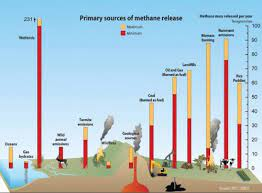
In the fight against climate change, most people hear about carbon dioxide (CO2) as the main enemy. But there is another gas that is 80 times more powerful than CO2 when it comes to trapping heat in the atmosphere — methane (CH₄).
Methane is a greenhouse gas that comes from natural sources like wetlands, but more importantly, from human activities such as farming, landfills, oil and gas production, and even the way we manage waste. The problem with methane is that even though it doesn’t stay in the atmosphere as long as CO2 (about 12 years compared to centuries for CO2), its impact on global warming is much stronger during that short time.

According to recent studies and reports by the United Nations Environment Programme (UNEP) and the International Energy Agency (IEA), methane emissions have been rising fast in the past few decades. But what is causing this rise?
Here are the main reasons:
Many experts call methane a “super pollutant” because of its strength in trapping heat. Here’s why it matters:
The worst part? A lot of these emissions are avoidable. Simple technologies like leak detection systems, better waste management, and improved farming techniques can greatly reduce methane emissions.
In 2021, more than 100 countries joined the Global Methane Pledge to cut methane emissions by 30% by 2030. This could help avoid nearly 0.2°C of warming by 2050, according to scientists. Major oil and gas companies are also being pushed to fix their pipelines and capture leaked methane instead of releasing it.
Governments are now taking action in these ways:
But progress is slow in many parts of the world due to lack of money, technology, or political will.
While big industries and governments play the biggest role, individuals can also help reduce methane emissions:

Unlike carbon dioxide, which can remain in the air for centuries, cutting methane emissions can deliver quick benefits for the climate. Reducing methane could help the world avoid dangerous climate tipping points like melting ice sheets and extreme weather patterns.
The good news is that most methane reduction solutions are available today — and many are cost-effective. For example, fixing gas leaks often saves companies money by capturing valuable fuel instead of wasting it.
But time is running out. Experts warn that if we do not cut methane emissions soon, it will be much harder to keep global warming below 1.5°C, the target set by the Paris Agreement.
Methane emissions are a hidden but deadly threat to the Earth’s climate. While carbon dioxide gets the most attention, methane is quietly making global warming worse — faster. The good news is that we have the tools, technology, and knowledge to fix this problem. But action is needed now, before the damage becomes impossible to undo.
If countries, industries, and individuals all do their part, we can cut methane emissions sharply and slow down climate change in a meaningful way.
Read More:- Shobha Realty Launches Its Most Luxurious Project Yet—Full Details Inside 2025
